The view from abroad
When many people think of Spain, they have romanticised notions of drinking wine or sangría on a terraza in the sun somewhere.
Beer drinking countries, the stereotype goes, are the colder countries in Northern Europe. And there’s some truth to that – some of the biggest drinkers in Europe are the Czechs, Germans, Britons, and Irish.
Do the Spanish like their wine? Of course. In fact, the average Spaniard drank 23.9 litres of wine in 2020, and Spain is also a massive producer of wine, boasting 969,000 hectares of vineyards – more than in both France and Italy and around 13 percent of all vineyards around the world.
But if you’ve lived or spent any time in Spain, you’ll know that Spaniards also love beer and that it’s actually far more common to see someone drinking a caña (a small glass of beer) in a bar than it is a glass of tinto.
Spanish beer culture
For as much as they love beer however, Spanish beer culture is a little more basic than in other countries.
More often than not, a Spanish person will ask for a caña without specifying what type of beer they want or what brand, something unthinkable in Northern Europe.
That’s because for many Spaniards, beer is beer. And they love it – drinking between 40-50 litres of beer per head per year – but the Spanish beer market is mostly dominated by three major brewers: Heineken España, who produce Cruzcampo, San Miguel-Mahou, and Damm, who make Estrella Damm.

Sometimes, bars will only have one or two beers on tap (sometimes just one main tap and another of the same brand but alcohol-free, something popular in Spain) from the main commercial brewers and these are almost always lighter lagers.
Regional differences
Beers also tend be quite regional in Spain.
If you’re drinking in Seville, for example, you’ll find almost every bar serves Cruzcampo.
In Madrid, there’ll be more Mahou Cinco Estrellas. In Valencia, it could be Turia or Aguila. Up in Galicia, most people drink Estrella. But as the map below reflects, there are other beers produced across the country, from Dorada and Tropical in the Canary Islands to Ambar in Zaragoza.
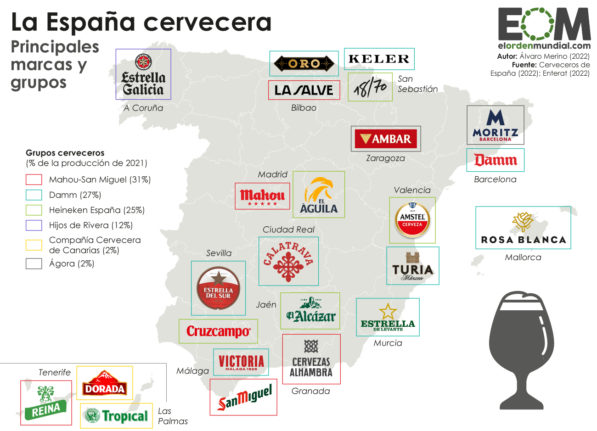
As we mentioned previously, Spaniards generally don’t drink pints like the Northern Europeans but rather smaller measures known as cañas, which in some parts of Spain are called zurito, corto or even penalti. They can vary in size depending on the region but usually they’re just 20cl.
If you want a big beer, you can order a jarra (jug), which can be even bigger than a pint. In Madrid, if you order a doble (double) you’ll get a beer that’s around 40cl. In the Basque Country, they call these bigger beers cañón.
Most bars generally have some form of 33cl bottled beer as well, often called un tercio, so you can always ask what cervezas de botella they have.
READ ALSO: ¡Salud! The different ways to say cheers in Spanish
The rise of craft beers
The craft beer scene, long established in Northern Europe and the United States, is starting to take off in Spain.
In recent years, craft or artisan beers (cervezas artesanales) have grown in popularity in Spain and it’s more common than ever to find bars and restaurants that stock them.
According to the Spanish Agency for Food Safety and Nutrition, in 2008 there were just 21 microbreweries in Spain. By the end of 2015, that number was 361, a huge increase of about 1,600 percent. In 2022 there are 420.
Catalonia is the region with the most craft breweries, followed by Andalusia and Castilla y León. It’s also possible to go on some guided tours of them and some craft beer tasting (Google visita guiada cerveza artesanal and your city or region to find ones close to you).
Data from the Artisan and Independent Beer Report revealed a 79.58 percent growth in Spanish craft beer production from 2015 to 2019, from 12.4 million litres to 22.4 million.
Although craft beer is on the rise in Spain, only one in every 200 beers produced in Spain is currently artesanal.
Despite that, independent brewers are having their beers stocked and served in more supermarkets and restaurants than ever before in Spain, and the country’s big brewers are producing a wider variety of stout, IPAs and toasted beers to compete with them.
That means that if you don’t want una rubia (a blonde beer), you’ll probably be able to order another kind of cerveza in most bars and restaurants in Spain.
Six of the best Spanish craft beers to try
La Socarrada
This craft beer from Játiva (Valencia) stays true to Valencian culture and takes its name from the paella socarrat – the delicious crispy layer of rice at the bottom of paella. As you might expect, this beer has a toasted flavour, and rosemary and Mediterranean honey are added during preparation.
Don’t just take our word for it: La Socarrada has been internationally endorsed at the International Taste & Quality Institute in Belgium, the Dublin Craft Beer Cup, and the Commonwealth Cup in the United States. It’s also one of the few Spanish craft beers sold internationally.
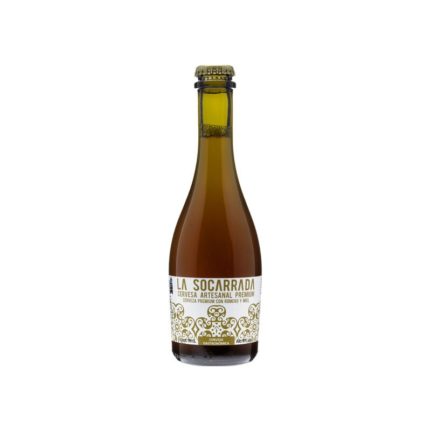
Arriaca
Cervezas Arriaca started production as an artisan brewer in Yunquera de Henares (Guadalajara) in 2014, and success quickly followed. Arriaca beers have 30 national and international recognitions and awards, firmly establishing itself as one of the leading craft beer brands in Spain, producing varieties of blonde, Wheat, Rye, Radler, Session IPA, IPA, Imperial Red IPA, Imperial Russian Stout and Porter. It’s no wonder the brewers at Arriaca are some of the founding members of AECAI (Spanish Association of Independent Artisan Brewers).
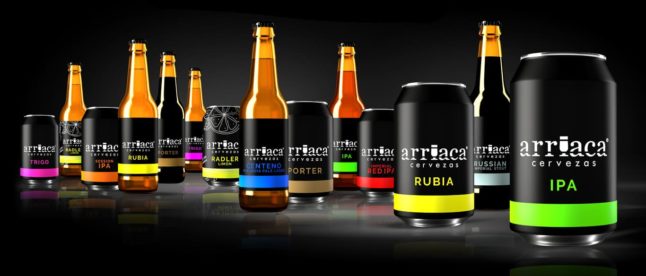
Chula Sin
As you’ve probably noticed, alcohol-free beers (known as cervezas sin alcohol, or simply ‘una sin‘) are incredibly popular in Spain. Given their prevalence in Spain, it’s no surprise that the hipster breweries have also had a go at producing alcohol-free beers. A particularly good one is Chula Sin, the first non-alcoholic craft beer in Spain, made with a blend of the best malt and hops in Spain and balanced with American Hops for a taste so good you wouldn’t know it’s alcohol-free.
The Madrid brewers also have a delicious wheat beer called Cheli and a very strong ale called Ziva 2.0.

Unika Beers
This Catalan-based brewer is something for the foodies among us. Unika Beers are a little different, even by craft beer standards, and aim to produce beers with a gastronomic twist that accompany food. Their beers are featured on the menus of over 200 restaurants and cocktail bars, Unika beers are made from 100 percent natural ingredients – they even brew a gluten-free beer suitable for celiacs.

Basqueland Brewing
Basqueland Brewing produce award-winning beer on the outskirts of San Sebastián by the Bay of Biscay. Born in 2015, the Basque brewers are some of the most productive in Spain, creating around 80 new beers a year, and won the Brewer of the Year award in 2021 at the Barcelona Beer Challenge.
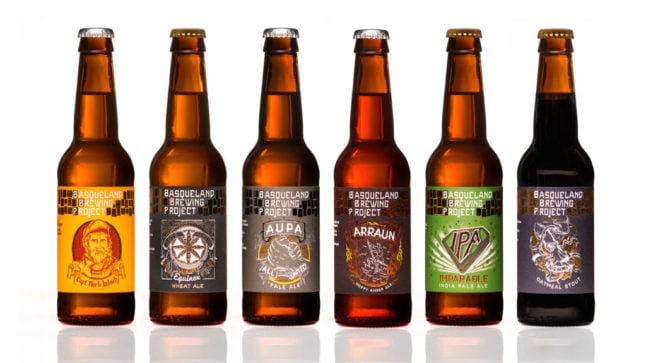
Cerveza La Virgen
This Madrid-based brewer began in 2012 and by 2019 had established itself as a leader in the Spanish craft beer scene. La Virgen was named the Best Lager in Spain by the World Beer Awards for 4 consecutive years in 2016, 2017, 2018 and 2019.
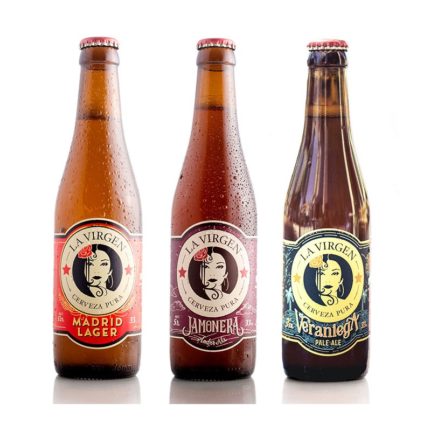

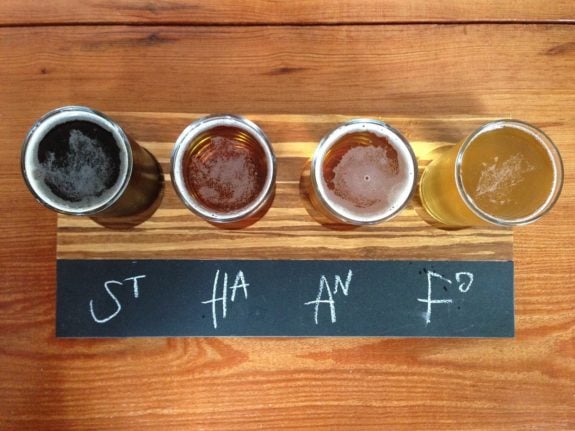

 Please whitelist us to continue reading.
Please whitelist us to continue reading.
Member comments